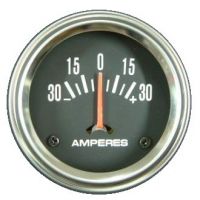An ammeter, as someone already said, measures the current flow in and out of the battery. If the battery is carrying a load, like the flaps or landing light, it will indicate a discharge. The ammeter will indicate a charge only when the alternator is recharging the battery. The current used by flaps or lights or anything else, while the engine is running and the alternator is working, does not pass through the ammeter and it will only give a small flick when you switch something on. That flick will be a brief discharge, very brief, because the voltage regulator senses the voltage drop in the whole system as the amperage increases and it sends more field current to the alternator and brings everything back to normal. The battery carried a bit of the load for a tiny bit before the voltage regulator caught up.
A loadmeter, on the other hand, measures everything the alternator is putting out and will increase as you add loads like flaps and lights. Different system. It is between the alternator and bus, while the ammeter is between battery and bus.
Your 172 has an ammeter. If it indicates zero in the runup, and you actuate the flaps, it should stay at zero except for that tiny flicker of the needle. If you turn everything on--all the radios, all the lights, and hit the flap switch, it should still read zero. If it indicates a discharge, the alternator needs work. Alternators are sized to carry all the loads at once in a light aircraft at such RPM, which is why the regulator doesn't have a current limiter like the old generator regulators did.
Dan








